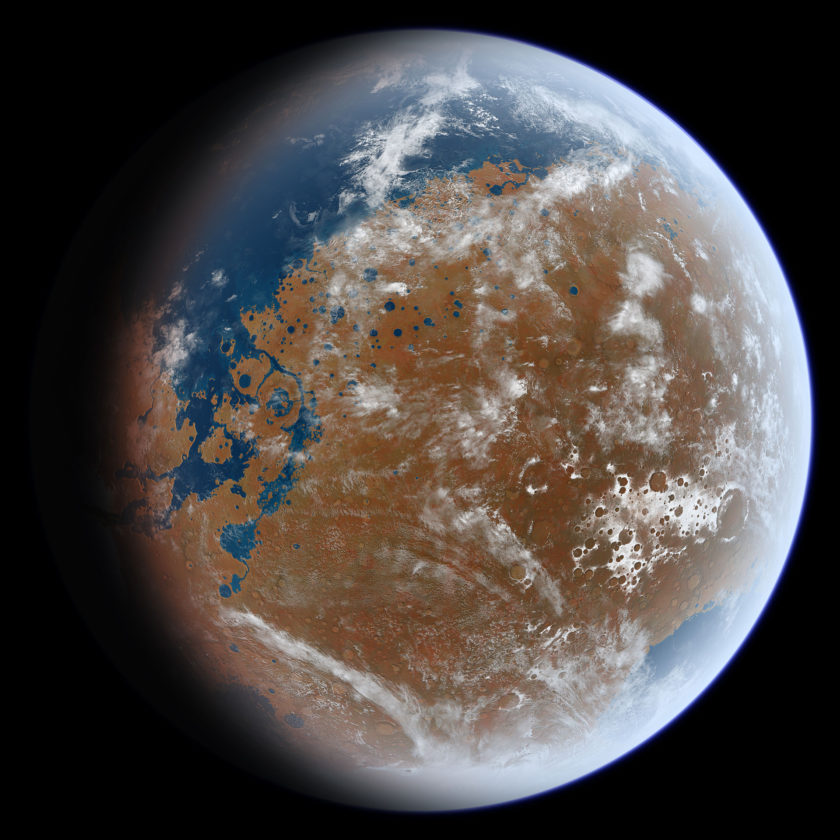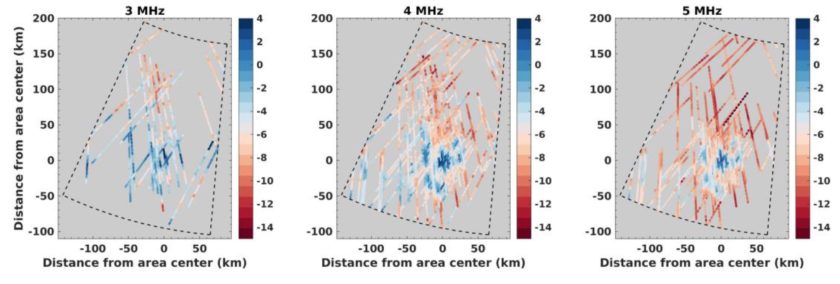
Within a study published on Sept 28, 2020 in Nature Astronomy we learn that lakes of liquid water have been detected on Mars.
This perhaps warrants being put in context. It is not as new, nor as dramatic, and not even as certain as you might be led to believe by the various headlines.
Briefly ..
- Back in 2018 a study revealed that a blob in radar mapping data suggested a lake existing under the polar ice cap
- This new study now revisits that by including additional scans that appear to confirm the earlier finding.
Let’s take a closer look.
Study: Multiple subglacial water bodies below the south pole of Mars unveiled by new MARSIS data
As I explained above, what might surprise some is that this is not wholly new. In July 2018, scientists from the Italian Space Agency reported the detection of a subglacial lake on Mars, 1.5 kilometres (1 mi) below the southern polar ice cap, and spanning 20 kilometres (10 mi) horizontally, the first evidence for a stable body of liquid water on the planet.
- AAAS Science: Radar evidence of subglacial liquid water on Mars
Many doubted the claim and wanted to see more evidence. This is what that new study does.
What is new?
Back in 2018, the evidence for this Martian lake was deduced from a bright spot in the radar echo sounding data.
What this new study does is to confirm that earlier discovery. It uses new data, and reanalyses all the data with a new technique.
This new radar study reveals three more subglacial lakes on Mars. All are 1.5 km (0.93 mi) below the southern polar ice cap. The size of the first lake found, and the largest, has been corrected to 30 km (19 mi) wide. It is surrounded by 3 smaller lakes, each a few kilometres wide.

A lake that is 1.5 Km down is a long way, so you might wonder what is sitting on top.
This is the MARS polar ice cap, so the layer on top is assumed to be frozen water ice. Not exactly a surprise given that the temperatures here are −68 °C ( −91 °F ). Sitting on top of that will be the 1 meter layer of seasonal frozen CO2
Is it really liquid?
The new study lays it out as follows …
Our results strengthen the claim of the detection of a liquid water body at Ultimi Scopuli and indicate the presence of other wet areas nearby. We suggest that the waters are hypersaline perchlorate brines, known to form at Martian polar regions and thought to survive for an extended period of time on a geological scale at below-eutectic temperatures.
Why is this a big deal?
The significance is the possibility of a habitat for life.
The earlier 2018 study was based on just 29 observations made from 2012 to 2015, hence many expressed doubt and wanted more evidence to support the claim. This latest study used a broader data set comprising 134 observations from 2012 to 2019 so it strengthens that earlier claim.
How do you use Radar to detect that it really is water and not ice?
The team used a radar instrument on Mars Express called the Mars Advanced Radar for Subsurface and Ionosphere Sounding (MARSIS) to probe the planet’s southern polar region. MARSIS sends out radio waves that bounce off layers of material in the planet’s surface and subsurface. The way the signal is reflected back indicates the kind of material that is present at a particular location — rock, ice or water, for example. A similar method is used to identify subsurface glacial lakes on Earth. The team detected some areas of high reflectivity that they say indicate bodies of liquid water .
Surface water is not possible because the of the lack of atmosphere, but the possibility of water trapped under the surface has been a subject of speculation. These could be potential habitats for Martian life.
However, if there is too much salt, then perhaps not.
Does this truly confirm the 2018 claim?
It strengthens the case for it, but some subject matter experts still have reasonable doubts.
“If the bright material really is liquid water, I think it’s more likely to represent some sort of slush or sludge,”
Mike Sori, a planetary geophysicist at Purdue University in West Lafayette, Indiana.
“I do not think there are lakes,” says Holt, who is on the science team for the Mars Shallow Radar sounder (SHARAD) on NASA’s Mars Reconnaissance Orbiter. “There is not enough heat flow to support a brine here, even under the ice cap.”
Jack Holt, a planetary scientist at the University of Arizona in Tucson
What comes next?
More analysis, more scans, more missions. Step by step, slowly slowly over time, more evidence will emerge and a case will be built up.
In Feb 2021 China’s Tianwen-1 mission will enter orbit. It will have radar equipment and so further data may soon become available.
“There may have been a lot of water on Mars, and if there was water, there was the possibility of life.”
Elena Pettinelli at the University of Rome, who is one of the paper’s co-authors
